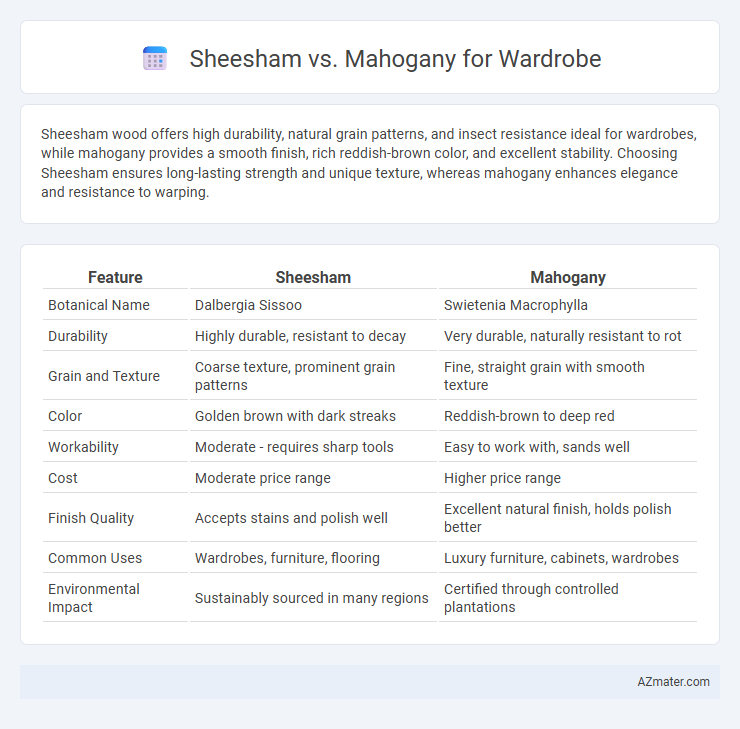Sheesham wood offers high durability, natural grain patterns, and insect resistance ideal for wardrobes, while mahogany provides a smooth finish, rich reddish-brown color, and excellent stability. Choosing Sheesham ensures long-lasting strength and unique texture, whereas mahogany enhances elegance and resistance to warping.
Table of Comparison
| Feature | Sheesham | Mahogany |
|---|---|---|
| Botanical Name | Dalbergia Sissoo | Swietenia Macrophylla |
| Durability | Highly durable, resistant to decay | Very durable, naturally resistant to rot |
| Grain and Texture | Coarse texture, prominent grain patterns | Fine, straight grain with smooth texture |
| Color | Golden brown with dark streaks | Reddish-brown to deep red |
| Workability | Moderate - requires sharp tools | Easy to work with, sands well |
| Cost | Moderate price range | Higher price range |
| Finish Quality | Accepts stains and polish well | Excellent natural finish, holds polish better |
| Common Uses | Wardrobes, furniture, flooring | Luxury furniture, cabinets, wardrobes |
| Environmental Impact | Sustainably sourced in many regions | Certified through controlled plantations |
Introduction to Sheesham and Mahogany Wood
Sheesham wood, also known as Indian Rosewood, is prized for its rich grain patterns and natural durability, making it a popular choice for premium wardrobe construction. Mahogany wood features a deep reddish-brown hue and exceptional resistance to rot and insects, often used in high-end furniture for its classic elegance and strength. Both woods offer superior hardness and longevity, but Sheesham is valued for its intricate grain, while Mahogany stands out for its smooth finish and uniform texture.
Sheesham vs Mahogany: Appearance and Grain Patterns
Sheesham wood features a rich, golden-brown hue with intricate, wavy grain patterns that add natural character and warmth to wardrobes. Mahogany offers a deeper reddish-brown color with a more uniform, straight grain, giving wardrobes a classic and elegant look. The contrasting grain structures and color tones of Sheesham and Mahogany influence the overall aesthetic appeal and design versatility for wardrobe cabinetry.
Durability and Strength Comparison
Sheesham wood offers exceptional durability due to its dense grain structure, making it highly resistant to wear and insect attacks, ideal for long-lasting wardrobes. Mahogany provides superior strength with its tight grain patterns and natural oils, ensuring robust construction and enhanced resistance to moisture. Between the two, Sheesham excels in hardness and resistance to environmental factors, while Mahogany delivers better structural integrity and longevity under heavy use.
Resistance to Termites and Decay
Sheesham wood, known for its natural oils, exhibits strong resistance to termites and decay, making it a durable option for wardrobes in humid environments. Mahogany also offers good resistance to termite attacks and fungal decay due to its dense grain and natural tannins, enhancing its longevity. Both woods provide reliable durability, but Sheesham's higher oil content often gives it an edge in termite-prone areas.
Maintenance Requirements for Wardrobes
Sheesham wood requires moderate maintenance involving regular polishing and protection from excessive moisture to prevent warping and enhance its natural grain. Mahogany demands less frequent maintenance due to its natural resistance to pests and decay, making it ideal for wardrobes with long-term durability. Both woods benefit from controlled humidity environments to maintain structural integrity and appearance over time.
Color and Finishing Options
Sheesham wood offers a rich golden-brown hue with prominent grain patterns, ideal for wardrobes that require a warm, natural aesthetic, while mahogany provides a deeper reddish-brown tone that exudes luxury and timeless elegance. The finishing options for Sheesham typically emphasize clear varnishes or oil finishes to highlight its natural texture, whereas mahogany wardrobes often feature polished or lacquered finishes that enhance their smooth, lustrous appeal. Both woods allow for versatile customization, but mahogany's finer grain supports higher-gloss finishes, making it suitable for sleek, sophisticated wardrobe designs.
Cost Differences and Affordability
Sheesham wood is generally more affordable than mahogany, making it a cost-effective choice for wardrobe construction without compromising on durability. Mahogany's higher price reflects its premium quality, rich color, and fine grain, appealing to luxury furniture buyers. For budget-conscious consumers seeking a balance of style and strength, sheesham offers excellent value compared to the more expensive mahogany.
Eco-friendliness and Sustainability
Sheesham wood, sourced from Indian Rosewood trees, is highly eco-friendly due to its natural durability and slower growth, allowing sustainable harvesting without extensive deforestation. Mahogany, often harvested from tropical rainforests, poses more environmental concerns unless sourced from certified FSC plantations, as its demand contributes to habitat loss and deforestation. For wardrobe construction, Sheesham offers a sustainable option with less environmental impact, while Mahogany requires careful sourcing to ensure eco-friendliness.
Sheesham vs Mahogany: Style Versatility in Wardrobes
Sheesham wood offers a rich, warm grain with natural oiliness that enhances durability and gives wardrobes a rustic charm, making it ideal for traditional and contemporary designs. Mahogany features a uniform, reddish-brown hue and smooth texture, lending wardrobes a refined and classic aesthetic favored in luxury interiors. In terms of style versatility, Sheesham adapts well to eclectic and casual environments, while Mahogany complements formal and elegant decors, influencing the choice based on desired ambiance.
Final Verdict: Which Wood is Better for Your Wardrobe?
Sheesham offers durability, natural oil resistance, and a rich grain that ages gracefully, making it ideal for wardrobes that require long-lasting strength and a traditional look. Mahogany provides a smooth finish, excellent stability, and a luxurious reddish hue, perfect for wardrobes focused on aesthetic appeal and high-end design. For a wardrobe combining robust durability with elegant appearance, Mahogany is preferable, while Sheesham suits budget-conscious buyers seeking practical longevity.

Infographic: Sheesham vs Mahogany for Wardrobe
 azmater.com
azmater.com